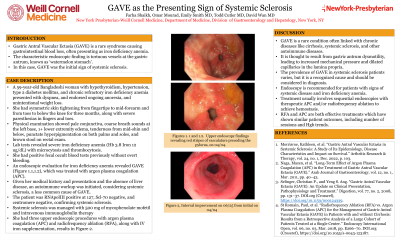Sunday Poster Session
Category: GI Bleeding
P0813 - GAVE as the Presenting Sign of Systemic Sclerosis
Sunday, October 27, 2024
3:30 PM - 7:00 PM ET
Location: Exhibit Hall E

Has Audio

Farha Shaikh
Weill Cornell Medicine
New York, NY
Presenting Author(s)
Farha Shaikh, 1, David Wan, MD2, Emily Smith, MD3, Omar Mourad, 1, Todd Cutler, MD1
1Weill Cornell Medicine, New York, NY; 2New York-Presbyterian / Weill Cornell Medical Center, New York, NY; 3New York-Presbyterian/Weill Cornell, New York, NY
Introduction: Gastric Antral Vascular Ectasia (GAVE) is a rare syndrome causing gastrointestinal blood loss, often presenting as iron deficiency anemia. The characteristic endoscopic finding is tortuous vessels at the gastric antrum, known as ‘watermelon stomach’. In this case, GAVE was the initial sign of systemic sclerosis.
Case Description/Methods: A 59-year-old Bangladeshi woman with hypothyroidism, hypertension, type 2 diabetes mellitus, and chronic refractory iron deficiency anemia presented with dyspnea, and endorsed ongoing anorexia, and unintentional weight loss. She had symmetric skin tightening from fingertips to mid-forearm and from toes to below the knee for three months, along with severe paresthesias in fingers and toes. Physical examination showed pale conjunctiva, coarse breath sounds at the left base, 1+ lower extremity edema, tenderness from mid-shin and below, punctate hyperpigmentation on both palms and soles, and brown stool on rectal exam. Lab tests revealed severe iron deficiency anemia (Hb 3.8 g/dl) with microcytosis and thrombocytosis. She had positive fecal occult blood tests previously without overt bleeding. An endoscopic evaluation for iron deficiency anemia revealed GAVE, which was treated with argon plasma coagulation (APC). Given her medical history and presentation and the absence of liver disease, an autoimmune workup was initiated, considering systemic sclerosis, a less common cause of GAVE. The patient was RNApolIII positive at 127 units, Scl-70 negative, and centromere negative, confirming systemic sclerosis. She had three upper endoscopic procedures with APC and radiofrequency ablation, along with IV iron supplementation, resolving her anemia. Systemic sclerosis was managed with 500 mg of mycophenolate mofetil and intravenous immunoglobulin therapy, slowing the progression of her neurocutaneous symptoms.
Discussion: GAVE is a rare condition often linked with chronic diseases like cirrhosis, systemic sclerosis, and other autoimmune diseases. It is thought to result from gastric antrum dysmotility, leading to increased mechanical pressure and dilated capillaries in the lamina propria. The prevalence of GAVE in systemic sclerosis patients varies, but it is a recognized cause and should be considered in diagnosis. Endoscopy is recommended for patients with signs of systemic disease and iron deficiency anemia. Treatment usually involves sequential endoscopies with therapeutic APC and/or radiofrequency ablation to achieve hemostasis.

Disclosures:
Farha Shaikh, 1, David Wan, MD2, Emily Smith, MD3, Omar Mourad, 1, Todd Cutler, MD1. P0813 - GAVE as the Presenting Sign of Systemic Sclerosis, ACG 2024 Annual Scientific Meeting Abstracts. Philadelphia, PA: American College of Gastroenterology.
1Weill Cornell Medicine, New York, NY; 2New York-Presbyterian / Weill Cornell Medical Center, New York, NY; 3New York-Presbyterian/Weill Cornell, New York, NY
Introduction: Gastric Antral Vascular Ectasia (GAVE) is a rare syndrome causing gastrointestinal blood loss, often presenting as iron deficiency anemia. The characteristic endoscopic finding is tortuous vessels at the gastric antrum, known as ‘watermelon stomach’. In this case, GAVE was the initial sign of systemic sclerosis.
Case Description/Methods: A 59-year-old Bangladeshi woman with hypothyroidism, hypertension, type 2 diabetes mellitus, and chronic refractory iron deficiency anemia presented with dyspnea, and endorsed ongoing anorexia, and unintentional weight loss. She had symmetric skin tightening from fingertips to mid-forearm and from toes to below the knee for three months, along with severe paresthesias in fingers and toes. Physical examination showed pale conjunctiva, coarse breath sounds at the left base, 1+ lower extremity edema, tenderness from mid-shin and below, punctate hyperpigmentation on both palms and soles, and brown stool on rectal exam. Lab tests revealed severe iron deficiency anemia (Hb 3.8 g/dl) with microcytosis and thrombocytosis. She had positive fecal occult blood tests previously without overt bleeding. An endoscopic evaluation for iron deficiency anemia revealed GAVE, which was treated with argon plasma coagulation (APC). Given her medical history and presentation and the absence of liver disease, an autoimmune workup was initiated, considering systemic sclerosis, a less common cause of GAVE. The patient was RNApolIII positive at 127 units, Scl-70 negative, and centromere negative, confirming systemic sclerosis. She had three upper endoscopic procedures with APC and radiofrequency ablation, along with IV iron supplementation, resolving her anemia. Systemic sclerosis was managed with 500 mg of mycophenolate mofetil and intravenous immunoglobulin therapy, slowing the progression of her neurocutaneous symptoms.
Discussion: GAVE is a rare condition often linked with chronic diseases like cirrhosis, systemic sclerosis, and other autoimmune diseases. It is thought to result from gastric antrum dysmotility, leading to increased mechanical pressure and dilated capillaries in the lamina propria. The prevalence of GAVE in systemic sclerosis patients varies, but it is a recognized cause and should be considered in diagnosis. Endoscopy is recommended for patients with signs of systemic disease and iron deficiency anemia. Treatment usually involves sequential endoscopies with therapeutic APC and/or radiofrequency ablation to achieve hemostasis.

Figure: A and B: Pre pyloric stomach
Disclosures:
Farha Shaikh indicated no relevant financial relationships.
David Wan indicated no relevant financial relationships.
Emily Smith indicated no relevant financial relationships.
Omar Mourad indicated no relevant financial relationships.
Todd Cutler indicated no relevant financial relationships.
Farha Shaikh, 1, David Wan, MD2, Emily Smith, MD3, Omar Mourad, 1, Todd Cutler, MD1. P0813 - GAVE as the Presenting Sign of Systemic Sclerosis, ACG 2024 Annual Scientific Meeting Abstracts. Philadelphia, PA: American College of Gastroenterology.

